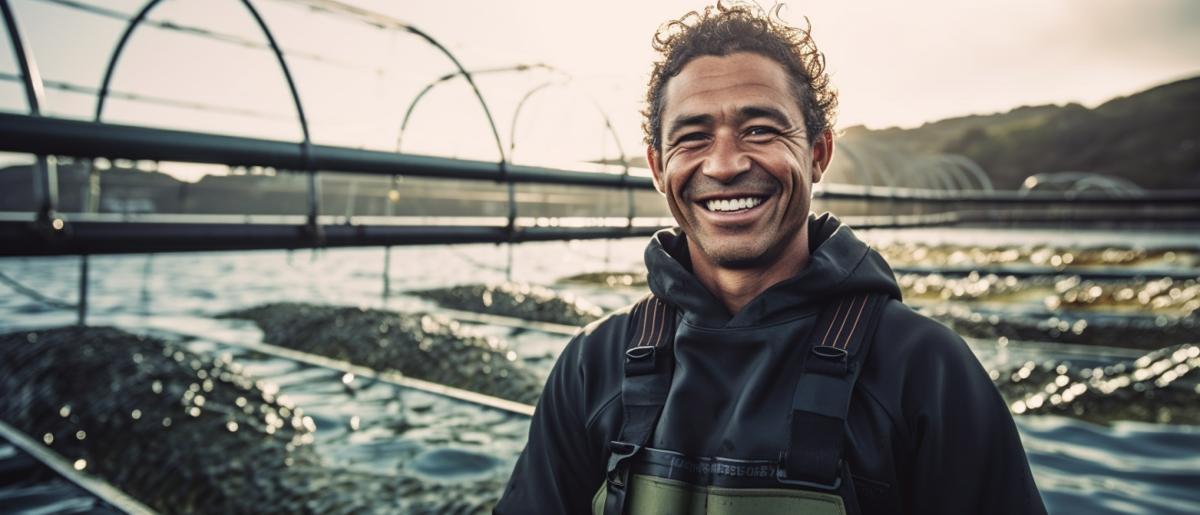

Business loans offer a vital lifeline for Offshore Cage Aquaculturists in Australia. As operators in an industry with considerable outlays for equipment maintenance, licencing compliance, environmental safety measures, and unpredictable variables like weather conditions and marine life behaviour, access to additional capital means resilience. The economic landscape and the industry's inherently demanding nature make additional funding a necessity. Business loans, in this context, don't just provide emergency relief, but help manage everyday expenses, facilitate essential updates to technology or equipment, and even catalyse expansion into new territories. In an industry as capital-intensive and subject to rapid shifts as offshore cage aquaculture, maintaining the financial capacity to adapt is crucial. In essence, business loans serve as strategic tools that can drive local prosperity in the offshore cage aquaculture sector, stimulate Australia's blue economy, whilst ensuring sustainable practises are upheld and local communities supported. This is much more than an essential resource – it's a conduit for growth, innovation, and resilience in this pivotal sector.
Compare over 50+ lenders with one application.
Offshore Cage Aquaculturists form an integral segment of Australia's vibrant seafood industry. Encased in the vast, biodiverse waters of Australia's coastline, they cultivate a diverse array of seafood – from tropical fish to shellfish and everything in between. Offshore cage aquaculture harnesses Australia's pristine marine conditions to contribute significantly to meeting the nation's seafood demand while boosting the economy. This hardworking breed of farmers bolster not only the domestic market but also cater to international clientele, adding weight to Australia's export portfolio. Their strategic practises are instrumental for maintaining a balance in aquatic ecosystems by relieving pressure on wild fish stocks. The fine line they walk between production and sustainability is commendable. They drive innovation and advanced farming techniques to aid both the aquaculture industry and the preservation of ocean life. The leveraging of technology by offshore cage aquaculturists reflect forward-thinking strategies - turning obstacles into opportunities. From creating jobs and supporting rural communities to enriching culinary diversity, Offshore Cage Aquaculturists play a pervasive and expanding role. They are the unsung heroes of the deep, navigating the unchartered waters of the industry, and their contribution to Australia's economy and environmental stewardship paints a promising future. Their importance undeniably sends ripples across the country and beyond – making a splash on a global scale. In essence, Offshore Cage Aquaculturists form a lynchpin of the seafood industry in Australia, underlining a vital role in economic growth, biodiversity and sustainable futures. Their relentless spirit to keep the waters teeming with life is key to Australia's aquaculture success storey.
Learn about eligibility and how to apply.
In the vigourous world of offshore cage aquaculturists, Australia displays a unique set of challenges. Splashed across a vast coastline with varying weather patterns, the deep blue holds trials that shape this industry's resilience and innovation. The most pressing challenge is environmental. The unpredictability of severe weather events adds a layer of risk. Frequent storms and variation in water temperatures not only increase operational hazards but can also impact fish health and growth. Then, there’s the issue of high operational costs. Upfront costs for cage and equipment instalation, maintenance and repairs, as well as feed costs, can often balloon frighteningly. Add to this the cost of obtaining necessary permits, and navigating complex regulatory waters. It's an investment risk that can sometimes feel like a toss of a coin. Lastly, market volatility poses another crouching challenge. Fluctuating market prices for seafood, influenced by factors such as international competition, affect profitability. Domestic competition and ongoing global market pressures can leave Australian aquaculturists grappling with uncertain demand and revenue. These stated challenges lay the groundwork for why business loans become crucial for offshore cage aquaculturists. While loans may not eradicate these challenges, they provide capital to navigate them successfully, keeping businesses buoyant. Steady and reliable financial aid can enable lifecycle-based business planning, helping to manage the ebb and flow of operational expenses. Equipped with financial security, aquaculturists can focus their efforts on what matters most – the health of their underwater livestock and the sustainability of their operations.
Calculate your repayment estimates and more.
Seeking a business loan provides numerous benefits for Offshore Cage Aquaculturists. It is a financial tool that can bolster the operations, making it a potent antidote to many of the challenges we discussed earlier. A noticeable advantage that comes with a business loan is the immediate availability of funds for asset acquisition. When investing in state-of-the-art equipment or even an additional aquaculture cage, businesses may often face financial constraints. These valuable acquisitions can boost the production rate, improve the work efficiency and contribute significantly to the overall yield. However, they also come with substantial price tags. Having an accessible, timely financial support in the form of a business loan helps the aquaculturists proceed with these necessary purchases without a hitch. The flexibility that comes with business loans is yet another intrinsic benefit for the aquaculturists. These loans are usually not restricted in their use - they can be utilised in any way the business sees fit. It could be for maintenance or upgrade of equipment, workforce expansion, or even used for cash flow management during off-peak seasons. This discretionary use of funds is exceedingly crucial for offshore aquaculture given its highly variable nature, with differing yield rates, unpredictable weather conditions, and fluctuations in market prices. Lastly, a well-timed business loan promotes growth and expansion. For instance, Offshore Cage Aquaculturists who are aiming to reach larger markets, or those looking to expand their operations, can benefit from access to financing that reduces the lead time of such projects. An injection of funds can also serve as a significant morale booster, offering employees and stakeholders a renewed sense of optimism about the business's future, thus fostering a positive work environment. Overall, the smart application of a business loan can lead to sustainable growth, making it a worthwhile ally in combating the hurdles that Offshore Cage Aquaculturists face.
For Offshore Cage Aquaculturists in Australia, a variety of business loans are at their disposal. They could consider options such as short-term loans for immediate necessities, equipment financing loans for replacing or upgrading cages and maritime gear, and working capital loans to ensure daily operational costs are covered.
There are several types of business loans in Australia that can benefit Offshore Cage Aquaculturists. Each of these loan types has its unique features, advantages, and potential disadvantages. Here are some of the most common types of business loans for Offshore Cage Aquaculturists:
Business Overdraft
A business overdraft is a type of credit facility that allows offshore cage aquaculturists to draw more than their account balance. It's a flexible solution, especially for businesses that experience inconsistent cash inflow and outflow.
Term Loans
Term loans are a traditional form of financing with a set repayment term and interest rate. This type of loan is suitable for cage aquaculture businesses that require substantial capital for growth and expansion.
Equipment Financing
This loan type specifically caters to the needs of businesses in purchasing necessary aquaculture equipment. An equipment loan allows the business to have the needed gear in operation as the repayments are made.
Line of Credit
A line of credit offers flexible access to funds on an as-needs basis, up to a predetermined limit. This can be highly beneficial for businesses with variable costs such as those dealing with changing seasonal demands.
Invoice Financing
This loan type provides advance payment against the business's outstanding invoices. Invoice financing can help aquaculture firms manage their cash flow, especially if they have clients that pay on extended credit terms.
Trade Finance
Trade finance provides support to businesses that trade goods, in this case, seafood produce. It is designed to make the buying and selling process more manageable by easing the cash flow.
Commercial Property Loan
For aquaculturists considering purchasing or upgrading their offshore facility, a commercial property loan might be the best fit. This type of loan finances business-related real estate purchases.
Vehicle Financing
Vehicle financing supports businesses in purchasing vehicles necessary for operations. With it, the aquaculturists can procure boats for their offshore operations and make repayments over time.
Working Capital Loan
A working capital loan provides the necessary funds for day-to-day business operations. These loans assist in covering wages, repairs, or unexpected costs.
Unsecured Business Loan
Unsecured business loans provide funds without requiring collateral. Despite typically having higher interest rates, these loans can quickly finance business needs without risking personal or business assets.
Business loans can significantly enhance operations for Offshore Cage Aquaculturists in Australia. They can be used for improving aspects like cage infrastructure, boosting seafood stock, or enhancing technology for surveillance and efficient fish farming. Therefore, having access to business loans can provide a game-changing platform for the aquaculture industry.
Here are some common reasons Offshore Cage Aquaculturists use business loans:
Purchase and Maintenance of Marine Cages
A considerable portion of the loan can be allocated towards purchasing state-of-the-art offshore cages and investing in their upkeep. These cages are instrumental in housing fish stock and protecting it from predators.
Investment in Advanced Feeding Systems
Automatic feeders prove to be cost-effective in the long run, reducing labour costs and ensuring timely feeding, contributing to healthier fish stock and higher yield.
Upgrade Aquaculture Equipments
Technological advancements in aquaculture instruments like oxygen metres or temperature sensors foster efficiency and productivity. Procuring such tools helps in maintaining optimum living conditions for the fish.
Enhancement of Biosecurity Measures
Ensuring biosecurity through implementing health cheques, hygiene protocols, and disease control strategies is essential in maintaining produce quality. Funds can be channelled into strengthening these practises.
Installation of Surveillance Systems
Investment in high-quality surveillance systems for monitoring the cages, ensuring safety from poachers and tracking the health and number of fishes can be a prudent move.
Workforce Training and Development
Skilled labour is a critical asset. Investing in staff training for efficient cage maintenance, fish handling, and disease diagnosis increases productivity.
Expansion of Cultivation Capacity
Business loans can be utilised to increase the number of marine cages, thereby extending the culture volume and enhancing yield potential.
Establishing Processing Units
Setting up onsite processing facilities ensure fresh market deliveries and increases the company's scope to venture into value-added fisheries products.
Research and Development
Continuous R&D in areas such as fish breeding, disease control, and ecosystem management contribute to a sustainable and profitable business model.
Debt Consolidation
Loans can also be channelled into consolidating previous debts, reducing interest rates, and improving financial health.
To estimate your monthly repayments and the total cost of the loan, input the loan amount, loan term and interest rate into the calculator below. This helps you plan your budget and choose the most suitable loan terms.
These helpful FAQs will help you find the answers you need. If you can't find what you're looking for, you can request a callback below.